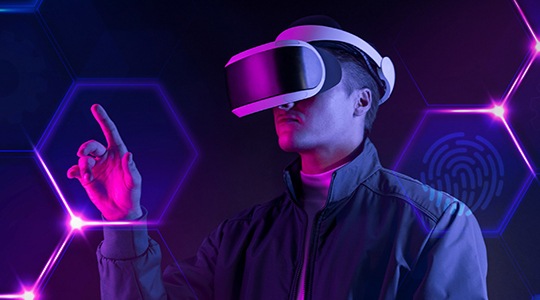Introduction
Virtual Reality (VR) has come a long way since its inception, transforming from a niche technology into a mainstream phenomenon. With advancements in hardware, software, and content creation, VR is poised for a bright future that promises to revolutionize various industries and our daily lives. In this blog post, we’ll delve into the cutting-edge trends and technological advancements that are shaping the future of virtual reality.
- Immersive Experiences Beyond Gaming
When VR was first introduced, it was primarily associated with gaming. However, the future of VR extends far beyond gaming consoles. We are witnessing a growing interest in using VR for educational, therapeutic, and professional applications. Medical professionals are using VR simulations for training, architects are designing virtual walkthroughs of buildings, and educators are creating immersive history lessons. The ability to transport users to different environments and scenarios is unlocking new possibilities in various sectors.
- Enhanced Hardware and Improved Comfort
One of the barriers to widespread VR adoption has been the discomfort associated with wearing VR headsets for extended periods. However, hardware manufacturers have been relentlessly working to address this issue. The future of VR headsets promises enhanced comfort, reduced weight, and improved ergonomics. Advancements like eye-tracking, foveated rendering, and higher resolution displays are making VR experiences more lifelike and less strenuous on the user’s eyes. Additionally, wireless VR solutions are becoming more prevalent, eliminating the need for cumbersome cables.
- Social Interaction in Virtual Spaces
The pandemic accelerated the demand for virtual social experiences. VR platforms like Oculus Horizon and Facebook Horizon Worlds are redefining the concept of social interaction. Users can gather in virtual spaces, attend concerts, play games, and even work together in a shared virtual environment. The future of VR social spaces holds the promise of connecting people from around the world in ways that were previously unimaginable.
- Augmented Reality (AR) and Mixed Reality (MR) Integration
While VR immerses users in entirely virtual worlds, Augmented Reality (AR) and Mixed Reality (MR) blend digital elements with the real world. The convergence of these technologies is creating exciting possibilities. Imagine wearing AR glasses that overlay digital information onto your physical surroundings or using MR for collaborative design projects where virtual objects interact with real-world objects. The future will likely see seamless integration between VR, AR, and MR, offering users a spectrum of immersive experiences.
- Realistic Haptic Feedback
For VR to truly mimic reality, it needs to engage not only our visual and auditory senses but also our sense of touch. Realistic haptic feedback technology is making significant strides, allowing users to feel textures, temperatures, and even forces in virtual environments. This innovation opens doors for applications in healthcare, where surgeons can practice procedures with lifelike feedback, and in gaming, where players can experience the impact of in-game actions physically.
- AI-Powered Content Creation and Personalization
Artificial Intelligence (AI) is playing a crucial role in the future of VR content creation. AI algorithms can generate virtual environments, characters, and even predict user behavior, making VR experiences more dynamic and adaptive. Moreover, AI-driven personalization will ensure that VR content caters to individual preferences, enhancing immersion and engagement.
- Accessibility and Inclusivity
As VR becomes more prevalent, ensuring accessibility and inclusivity is vital. Efforts are being made to create VR experiences that accommodate users with disabilities, such as providing alternative control methods for those with limited mobility or incorporating features for the visually impaired. The future of VR aims to be an inclusive space where everyone can participate and enjoy immersive experiences.
- Ethical and Privacy Considerations
With the increasing use of VR in social and professional settings, ethical and privacy concerns are emerging. Questions about data security, consent, and the potential for addiction are being addressed by developers and regulators. Striking a balance between innovation and safeguarding user rights will be a crucial aspect of the future of VR.
Conclusion
The future of virtual reality is brimming with potential, as the technology continues to evolve and expand into new domains. From immersive education to realistic haptic feedback and the integration of AR and MR, the possibilities are endless. As VR becomes more accessible, comfortable, and socially connected, it is set to redefine how we work, play, and interact with the digital world. Embracing these trends and technological advancements will be key to unlocking the full potential of VR in the years to come.




